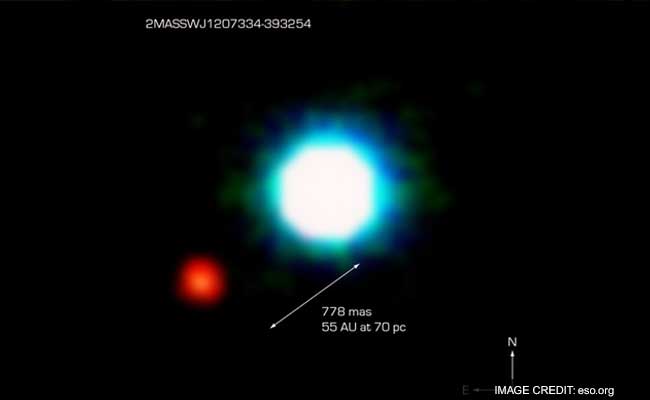
An artist's concept of 2M1207b, a planet that is four times the mass of Jupiter and orbits 5 billion miles from its brown dwarf companion object.
Washington:
Astronomers using NASA's Hubble Space Telescope have measured the rotation rate of an extreme exoplanet - about four times more massive than Jupiter - by observing the varied brightness in its atmosphere.
This is the first measurement of the rotation of a massive exoplanet using direct imaging, researchers said. The planet, called 2M1207b, is about four times more massive than Jupiter and is dubbed a "super-Jupiter."
It is a companion to a failed star known as a brown dwarf, orbiting the object at a distance of 5 billion miles.
By contrast, Jupiter is approximately 500 million miles from the Sun. The brown dwarf is known as 2M1207. The system resides 170 light-years away from Earth.
"The result is very exciting. It gives us a unique technique to explore the atmospheres of exoplanets and to measure their rotation rates," said Daniel Apai of the University of Arizona in Tucson, leader of the Hubble investigation.
The researchers attribute the brightness variation to complex clouds patterns in the planet's atmosphere. The new Hubble measurements not only verify the presence of these clouds, but also show that the cloud layers are patchy and colourless.
 Astronomers first observed the massive exoplanet 10 years ago with Hubble. The observations showed that the exoplanet's atmosphere is hot enough to have 'rain' clouds made of silicates - vapourised rock that cools down to form tiny particles with sizes similar to those in cigarette smoke.
Astronomers first observed the massive exoplanet 10 years ago with Hubble. The observations showed that the exoplanet's atmosphere is hot enough to have 'rain' clouds made of silicates - vapourised rock that cools down to form tiny particles with sizes similar to those in cigarette smoke.
Deeper into the atmosphere, iron droplets are forming and falling like rain, eventually evaporating as they enter the lower levels of the atmosphere.
"So at higher altitudes it rains glass, and at lower altitudes it rains iron. The atmospheric temperatures are between about 1204 to 1426 degrees Celsius," said Yifan Zhou from University of Arizona.
The super-Jupiter is so hot that it appears brightest in infrared light. Astronomers used Hubble's Wide Field Camera 3 to analyse the exoplanet in infrared light to explore the object's cloud cover and measure its rotation rate.
The planet is hot because it is only about 10 million years old and is still contracting and cooling, researchers said.
The planet, however, will not maintain these sizzling temperatures. Over the next few billion years, the object will cool and fade dramatically, they said.
As its temperature decreases, the iron and silicate clouds will also form lower and lower in the atmosphere and will eventually disappear from view.
Researchers also determined that the super-Jupiter completes one rotation approximately every 10 hours, spinning at about the same fast rate as Jupiter.
The findings were published in The Astrophysical Journal.
This is the first measurement of the rotation of a massive exoplanet using direct imaging, researchers said. The planet, called 2M1207b, is about four times more massive than Jupiter and is dubbed a "super-Jupiter."
It is a companion to a failed star known as a brown dwarf, orbiting the object at a distance of 5 billion miles.
By contrast, Jupiter is approximately 500 million miles from the Sun. The brown dwarf is known as 2M1207. The system resides 170 light-years away from Earth.
"The result is very exciting. It gives us a unique technique to explore the atmospheres of exoplanets and to measure their rotation rates," said Daniel Apai of the University of Arizona in Tucson, leader of the Hubble investigation.
The researchers attribute the brightness variation to complex clouds patterns in the planet's atmosphere. The new Hubble measurements not only verify the presence of these clouds, but also show that the cloud layers are patchy and colourless.

This composite image shows an exoplanet (the red spot on the lower left), orbiting the brown dwarf 2M1207 (centre). (File Photo)
Deeper into the atmosphere, iron droplets are forming and falling like rain, eventually evaporating as they enter the lower levels of the atmosphere.
"So at higher altitudes it rains glass, and at lower altitudes it rains iron. The atmospheric temperatures are between about 1204 to 1426 degrees Celsius," said Yifan Zhou from University of Arizona.
The super-Jupiter is so hot that it appears brightest in infrared light. Astronomers used Hubble's Wide Field Camera 3 to analyse the exoplanet in infrared light to explore the object's cloud cover and measure its rotation rate.
The planet is hot because it is only about 10 million years old and is still contracting and cooling, researchers said.
The planet, however, will not maintain these sizzling temperatures. Over the next few billion years, the object will cool and fade dramatically, they said.
As its temperature decreases, the iron and silicate clouds will also form lower and lower in the atmosphere and will eventually disappear from view.
Researchers also determined that the super-Jupiter completes one rotation approximately every 10 hours, spinning at about the same fast rate as Jupiter.
The findings were published in The Astrophysical Journal.
Track Latest News Live on NDTV.com and get news updates from India and around the world

